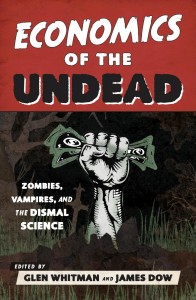CSUN Professors’ New Book Shines Light on the Economics of the Undead
 After spending most days at a desk staring at a computer, do you have the skills to survive the zombie apocalypse? What market forces are at play when “Twilight’s” Bella and Edward make eyes at each other, or which influence the fate of “True Blood’s” Sookie and Eric?
After spending most days at a desk staring at a computer, do you have the skills to survive the zombie apocalypse? What market forces are at play when “Twilight’s” Bella and Edward make eyes at each other, or which influence the fate of “True Blood’s” Sookie and Eric?
Those are just some of the questions California State University, Northridge economics professor Glen Whitman and finance professor James Dow explore in their new book, “Economics of the Undead: Zombies, Vampires, and the Dismal Science.”
The pair capitalize on popular culture’s fascination with the undead — from “The Vampire Diaries” and “True Blood” to “The Strain” and “The Walking Dead” — to help people understand economic systems, big and small.
Whitman and Dow noted that undead characters have terrified popular audiences for centuries, but when analyzed closely, their behaviors, however far-fetched, mirror the living’s in surprising ways.
“The book assumes that the reader has no prior knowledge of economics,” Dow said. “We figured that people can learn a little bit about economics in an interesting way.”
“Economics of the Undead” grew out of a shared love for the cult classic television show “Buffy the Vampire Slayer,” and a conundrum inspired by one of the show’s characters sneaking away to pay a vampire to suck his blood for the thrill.
“We thought, ‘Really? Wouldn’t the vampires pay the humans?’” Whitman said. “That got us thinking about vampires and zombies from an economic perspective.”
After kicking the idea around for a while, the pair invited colleagues from across the country — mostly economists, but also a couple of lawyers and literature professors — to seriously explore some of the basic economic issues raised by a world that included the undead.
Addressing the question of whether humans would pay vampires to suck their blood, Whitman said it turns on the relative size of vampire demand and human supply.

Glen Whitman
“Who pays whom? It depends on how much humans want to thrill-seek versus how much vampires need the blood,” Whitman said. “Another factor is how many vampires there are compared to humans, and whether it’s easier for vampires to buy the blood or take it by force.”
That availability, the number of humans versus number of vampires also factors into the latest trend — at least according to television, movies and pop fiction — of human girls dating vampire boys.
“Society has clearly evolved a great deal since the late 1800s, when the romantic relationships between Count Dracula and Lucy Westenra led a small group of fanatics to stake her, behead her, and stuff her mouth with garlic before tracking down Dracula himself,” Whitman notes in the book’s first chapter, “Human Girls and Vampire Boys, Part 1: Looking for Mr. Goodbite.” “Until recently, romantic relationships between the living and the dead were regarded with sheer horror. But Buffy, Bella, Sookie and Elena have blazed a trail that many young women are eager to follow. The human-vampire dating scene is taking off.
“Despite its unusual features, the mating market shares key features with other markets. The most salient of these is competition,” the chapter continues. “In general, more competition on the other side of the market is good for you… If vampire boys outnumber the human girls on the market, even an average girl has a chance of snagging a truly sparkly vamp.”

James Dow
Dow, in his chapter “Packing for the Apocalypse,” ponders what we need to bring with us in a world filled with zombies. He points out that while weight and volume don’t really factor into our decisions today, they matter a great deal once the world has succumbed to zombie domination.
Given that, and a thoughtful assessment of what skills might be needed post-zombie apocalypse, Dow concludes that he’ll be packing a portable distillery.
“Let’s face it, after the world has passed through a zombie apocalypse and civilization as we know it has collapsed, it’s probably alcohol that will be in popular demand,” Dow writes in the chapter.
Whitman’s chapter “Tragedy of the Blood Commons: The Case for the Privatizing of Humans” draws on the premise set out in the 2009 movie “Daybreakers,” where vampires dominate the world and there’s a dwindling blood supply. The chapter explores possible answers to global resource concerns, including the problems associated with overfishing.
“We have 10 percent of the large ocean fish that we had a century ago,” Whitman said. “Economics isone way to assess the situation and explore the question of why is it that when people demand more fish, it causes fewer fish to be in the ocean, yet when people demand more chicken, we get more chickens raised on farms.”
To illustrate why fish dwindle while chickens do not Whitman tells the story of the vampire Reynaldo He captures a woman to feed on and discovers she is pregnant. The character debates letting her go, in hopes that in the future, he’ll have two meals instead of one. However, there’s a possibility that another vampire may find her and enjoy the feast instead. So, he consumes the woman immediately
“The book can be beneficial as an educational tool,” Whitman said, noting that he and Dow have created a website for the book, http://econundead.com/, which includes a course guide for educators. “But the secret is, the book was put together by a couple of nerds who love zombies and vampires and wanted to look at them through an economic lens.”
“As for the goals for the readers?” Dow added with a chuckle. “Maybe they’ll learn something about how to prepare for the zombie apocalypse.”

 experience
experience